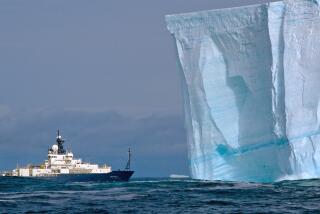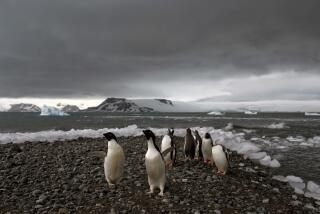South Light: A JOURNEY TO THE LAST CONTINENT by Michael Parfit (Macmillan: $17.95; 320 pp.)
- Share via
It is only fitting that the strangest place on Earth is graced with one of the more original travel accounts of recent years. Just about every attribute of Antarctica places it in a category all its own. Unlike the North Pole, the Southern one is underlain by bedrock: It is a real continent, and all the colder because of it. Other than penguins, seals and pelagic birds along the coast, Antarctica is populated by a few hundred military, technicians and scientists. They occupy permanent or seasonal research camps established by the governments of a potpourri of nations: the United States, Soviet Union and Great Britain by dint of history; New Zealand, Australia, Chile and Argentina on account of geography; Poland, South Africa, Japan and a smattering of others for reasons--like all of them--as much of territorial claim as pure science.
Michael Parfit, a Santa Barbara journalist dispatched to the south continent by Smithsonian magazine, spent the entire “summer” field season poking into odd corners of Antarctica and its unusual denizens. What came of it is “South Light”--a disconnected collection of photographs taken with the mind’s eye. Unusual people and strange actions come at you in staccato fashion, little dramas in a setting so alien that you want to demand of Parfit, “Explain this! Where are we?” Parfit, stubborn, does not succumb to that powerful journalist’s instinct to construct order.
All--or most, anyhow--eventually makes some sort of sense. In the meantime, you benefit from the heightened sensitivity cognitive dissonance offers, that sense of the incredibly new that Parfit experienced and that he shares with fine, clean, sharp prose. Unless you are a scientist or pure adventurer, Antarctica is mostly about highly trained people engaged in sophisticated and expensive research, and about surviving in the most hostile environment on Earth. Yet this is not “personal” journalism, reporter as hero. Parfit appears now and then, but mostly he prefers to be a transparent conduit to the life of the continent.
It is August--late winter--and Winfly, the winter flight to Antarctica, is under way, taking three Hercules LC-130 transports loaded with scientists and support staff and supplies for the United States Antarctic Research Program. Although these annual flights from Christchurch, New Zealand, to McMurdo Station are routine, they are far from safe or simple. This time, a sudden storm and whiteout is reported after the little squadron has passed the point of no return. After several tries, the lead plane is forced to land completely blind. Such is Antarctica’s greeting.
The Antarctic Treaty of 1961, which 18 nations have signed--including all physically represented there--bans weapons from the continent and sets aside all territorial claims. Treaty notwithstanding, the research stations scattered all over Antarctica serve not incidentally to establish and reinforce future claims, and it is no doubt this basis that justifies the extraordinary expense of pure scientific work in this extraordinary place. There is a New Zealand station at Vanda Lake, where Antarctica’s one river, Onyx, sometimes gets warm enough to flow into a lake that sometimes thaws about the edges. When Parfit visits, he is obliged to participate in one of those peculiar and awful rituals that evolve in out-of-the-way places: “That morning the Vandas had gone out about twenty yards from shore and hacked a hole through (the ice). They put up a sign and opened the most exclusive bathing organization in the world, the Royal Vanda Swim Club.” His description of joining that club is stupendously funny and awful.
The scientists are everywhere. One has an instrumented Weddell seal he’s studying to learn how these animals stay submerged for half an hour. Parfit is permitted to clamber down in a glass tube that permits him to watch seal behavior under the ice. Another project studies Dissostichus mawsoni , a fish that prevents itself from freezing by producing its own anti-freeze. But the kingfishes of the scientific community are its geologists. Antarctica possesses mountains more than 10,000 feet high, but it also is covered by two sheets of ice up to 6,000 feet thick.
One spectacular adventure for Parfit is a ship expedition--fighting through autumn ice floes and giant icebergs to visit, for the first time by anyone, a huge island volcano. The scientific ship Polar Sea literally breaks ice so that geologists can learn something of the nature of that volcano and the land mass’ mysterious past. “Mt. Siple was like all of Antarctica: Unlike everywhere else in the world, this place’s pioneers were not followed by the scientists--the pioneers were the scientists.”
Life, of necessity, is strange down there. Parfit reports a unique football game between the Navy and the civilian support staff in MacTown--McMurdo. MacTown features the California Hotel (two two-minute showers a week) and the Mammoth Mountain Inn. Staff seem to watch an endless stream of grade-B video movies while they try to cope with claustrophobia and the worst sex ratio outside San Quentin. For the most part, even staff from officially hostile nations get along well; they’re usually desperate for new faces. Traveling in a place where the time zones change every few miles and every direction is north is itself a journey into the bizarre.
This is simply a superb book. Parfit’s writing is splendid; it is witty and spare and marvelously timed. Parfit is intelligent and informed, which means that he has a reasonable understanding of the abstruse activities of Antarctica’s researchers, so the reader does too. Reading “South Light” is exciting enough to make you want to see the place yourself, and satisfying enough so that bitterly cold reality is unnecessary.
More to Read
Sign up for The Wild
We’ll help you find the best places to hike, bike and run, as well as the perfect silent spots for meditation and yoga.
You may occasionally receive promotional content from the Los Angeles Times.






